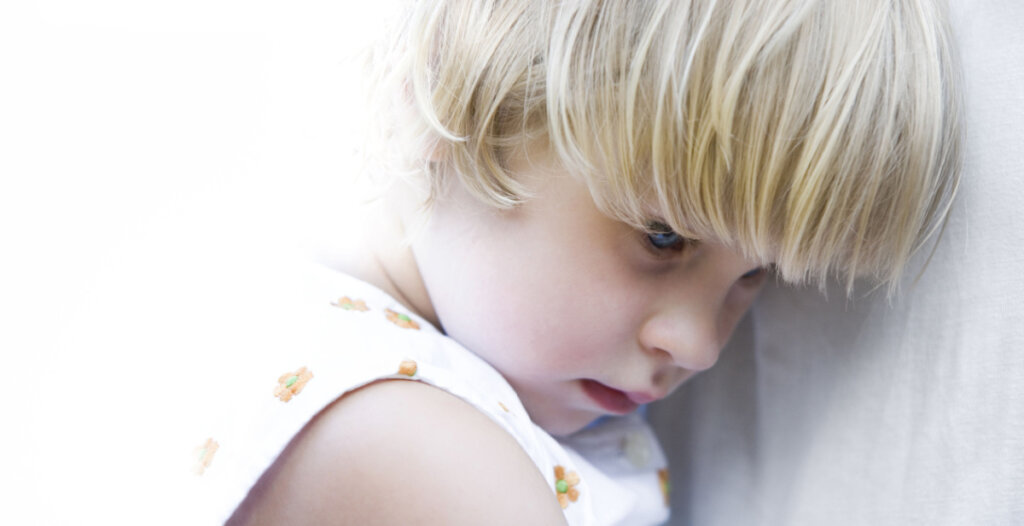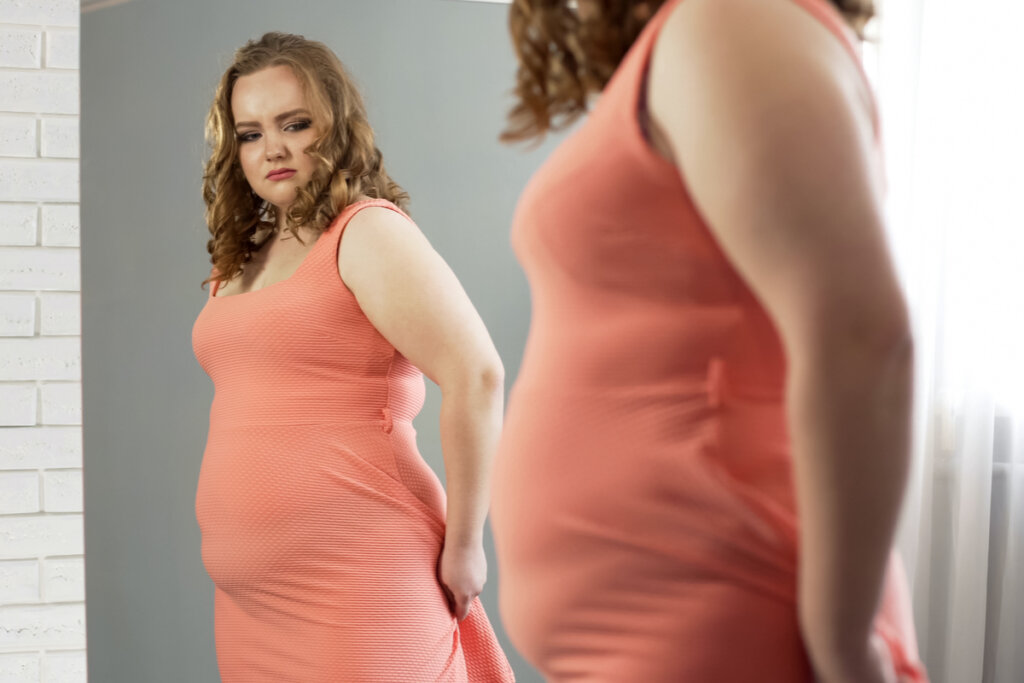Bodily Self-Awareness and Its Link With Suffering


Written and verified by the psychologist Valeria Sabater
Some people, when they look in the mirror, see an uncomfortable and unpleasant image. For instance, many teenagers only feel good about their image when they embellish or distort it with endless filters. As if this weren’t shocking enough, there’s something that’s even more terrifying. This is the fact that there’s currently an increasing number of children between the ages of six and eight who see numerous defects in their physical appearance.
In fact, millions of people worldwide struggle with body dissatisfaction. In the minds of these individuals, there appears to be an enormous distance between their real image and the one they see as ideal. However, this ideal image is both artificial and impossible. Consequently, it only leads them to feelings of discomfort and progressive self-rejection.
Bearing this in mind, it’s hardly surprising that body dysmorphic disorder is being diagnosed increasingly frequently. This is the condition in which the individual compulsively seeks perfection while being extremely critical of their own body. As such, they see defects where there are none and believe that their physical image is disturbing.
Anxiety, avoidance behaviors, obsessions, fears… When the mind meets a body with which it’s out of tune, the suffering is devastating. Indeed, bodily self-awareness and the way we build it are directly linked to our mental health. This is something we should attend to from childhood.
Parents have a direct impact on the development of their child’s body image.

The definition of bodily self-awareness
Bodily self-awareness is the process by which our brains integrate our physical images. It’s the way in which we construct the Self. Our perception of the physical areas of our body schemas builds the sensation of being who we are. A child integrates this physical-psychological craft from three years of age onwards.
Bodily self-awareness is probably more important than you think. That’s because for several centuries the body was viewed as being separate from the mind. This dualism is rooted in the classic seventeenth-century theory of René Descartes. It made it extremely difficult for people to understand that, sometimes, certain physical discomforts had a psychological origin and not so much a physiological one.
It’s been known for decades that a child doesn’t come into the world hating their body. They learn it in society. Unsurprisingly, this affects their mental health in a devastating way. So much so that, a study conducted by several European universities claimed that, today, body dysmorphic disorder is increasingly common among young people.
Indeed, it seems that there are an increasing number of children and adolescents between the ages of ten and 19 who hate their bodies. Those who present this condition show, in turn, a psychiatric comorbidity of 71.5 percent with self-harm and suicide attempts. Clearly, bodily self-awareness is often the beginning of a great deal of suffering.
There are psychological disorders that block our bodily self-awareness, to the point of not feeling certain bodily sensations as our own and seeing physical defects that aren’t real.
The components of bodily self-awareness
Body self-awareness is rooted in the brain via three specific components. These mediate and allow us to understand the psychopathology of a large part of eating disorders (ED) and body dysmorphic disorder (BDD). They’re as follows:
- The physical property of the body (what we see). In other words, whatever catches our attention. Some people believe they look horrible, flawed, or even downright disgusting. It doesn’t matter that they might be attractive. Dysmorphophobia means that what they see in their mirror doesn’t correspond to reality.
- Interoception (what we feel). We build bodily self-awareness through our internal sensations, those that are triggered within us. Research conducted by the University of Rennes (France) claims that sufferers of anorexia or body dysmorphic disorder have altered perceptions of physiological hunger, satiety, and how emotions are expressed in the body.
- Cognitive evaluation (what we think). We build the ideas of who we are from how we see ourselves. In fact, thoughts and beliefs have great power when it comes to building healthy and positive images of ourselves.
When we disassociate from our bodies and reject them, we stop understanding how we feel and become detached from the good management of our emotions.

When mind and body aren’t in harmony
Bodily self-awareness establishes itself in our brains in childhood and can start to fray at any time. As a matter of fact, if mind and body stop being in harmony, the origin almost always lies in a foreign, strange, and extremely harmful third variable: our culture. Indeed, worryingly, the images we have of ourselves can be destroyed by the messages we receive from our environment.
The family is usually the first scenario to inject children with negative narratives about their body schemas. These early messages establish self-concept and self-esteem. Then, there’s the fashion and advertising industry as well as social media. On this platform, young people compare themselves daily with images they see on their Tik Tok and Instagram apps.
As a matter of fact, right now, social media is the main enemy of healthy body self-awareness in young people. It means their minds and bodies aren’t in harmony. This is highly problematic and we’re all aware of the issue. However, our society tackles it badly.
Detaching ourselves from our bodies
When our minds and bodies are out of sync, we experience a striking type of dissociation. In effect, we stop being in control of our emotions. Moreover, we suppress them, fail to understand them, and remain anchored to their negativity. We feel only rejection, criticism, persistent anxiety, and contempt.
A lack of bodily self-awareness promotes a lack of emotional self-awareness and, in turn, a distortion of the Self. It means our bodies are not our own. We deny them and distance ourselves from them and remain stranded in a dimension of permanent discomfort. The effects are immense.
So, what can we do in these circumstances? The responsibility lies with everyone. We live in a society dominated by the tyranny of an impossible, artificial beauty and governed by self-demand. Our bodies shouldn’t be our enemies. They’re part of us. We need to reformulate the way we think. Then, perhaps we’ll be able to prevent nine and ten-year-old children from being admitted as emergencies to eating disorders units.
All cited sources were thoroughly reviewed by our team to ensure their quality, reliability, currency, and validity. The bibliography of this article was considered reliable and of academic or scientific accuracy.
- AYRES AJ. Development of the body scheme in children. Am J Occup Ther. 1961 May-Jun; 15:99-102. PMID: 13685382.
- Keromnes, G., Chokron, S., Celume, M., Berthoz, A., Botbol, M., Canitano, R., Du Boisgueheneuc, F., Jaafari, N., Lavenne-Collot, N., Martin, B., Motillon, T., Thirioux, B., Scandurra, V., Wehrmann, M., Ghanizadeh, A., Tordjman, S. (2019). Exploring Self-Consciousness From Self- and Other-Image Recognition in the Mirror: Concepts and Evaluation. Frontiers in Psychology, 10. https://www.frontiersin.org/articles/10.3389/fpsyg.2019.00719
- Rabellino D, Frewen PA, McKinnon MC, Lanius RA. Peripersonal Space and Bodily Self-Consciousness: Implications for Psychological Trauma-Related Disorders. Front Neurosci. 2020 Dec 10; 14:586605. doi: 10.3389/fnins.2020.586605. PMID: 33362457; PMCID: PMC7758430.
- Rautio, D., Jassi, A., Krebs, G., Andrén, P., Monzani, B., Gumpert, M., Lewis, A., Peile, L., Sevilla-Cermeño, L., Jansson-Fröjmark, M., Lundgren, T., Hillborg, M., Silverberg-Morse, M., Clark, B., Fernández de la Cruz, L., & Mataix-Cols, D. (2022). Clinical characteristics of 172 children and adolescents with body dysmorphic disorder. European child & adolescent psychiatry, 31(1), 133–144. https://doi.org/10.1007/s00787-020-01677-3
- Theron WH, Nel EM, Lubbe AJ. Relationship between body-image and self-consciousness. Percept Mot Skills. 1991 Dec;73(3 Pt 1):979-83. doi: 10.2466/pms.1991.73.3.979. PMID: 1792148.
This text is provided for informational purposes only and does not replace consultation with a professional. If in doubt, consult your specialist.








